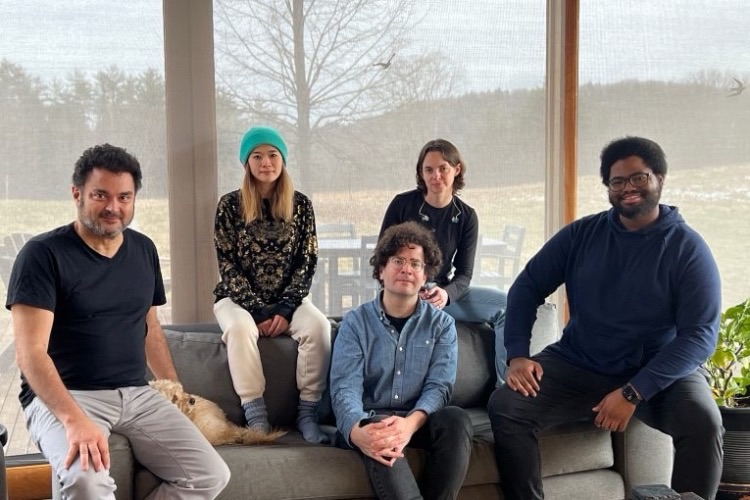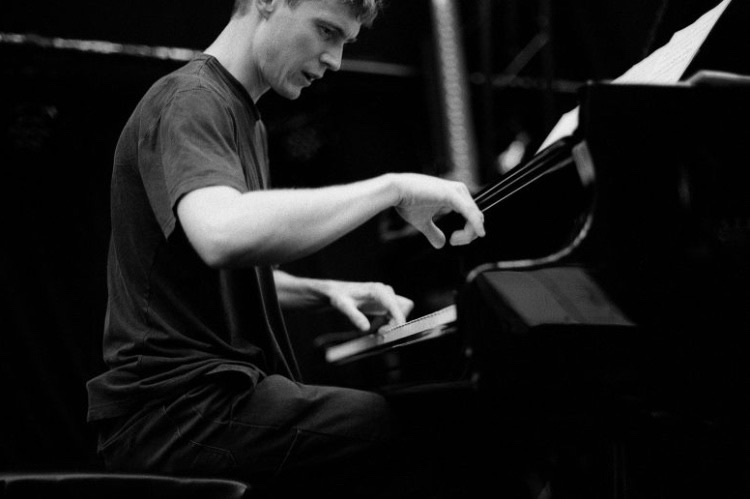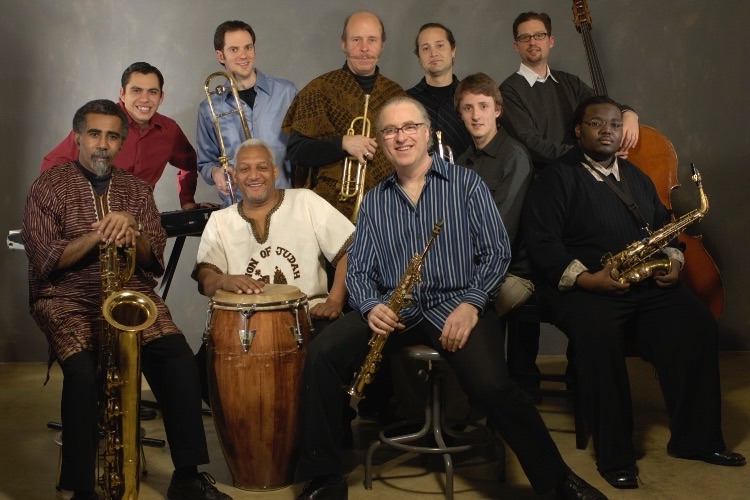Quilting Sound: A Conversation with Travis Laplante on ‘The Golden Lock’
In a recently published piece titled “19 Critically Acclaimed Albums That Nobody Actually Listens To,” writer Victoria Omololu attempts to minimize incredible recordings with significant artistic merit. In the process, however, she reveals the author’s ignorance on the topic far more than anything of substance. This is particularly blatant in her description of Miles Davis’ Bitches Brew (Columbia, 1970). While admitting that the album “changed the way people thought about jazz,” she nevertheless bashes the work for having “songs [that] are really long and don’t follow normal structures.” But the reality is that not every song can be some catchy three-minute pop jingle. Nor should they be. Sometimes, the lack of brevity can recover subtleties in the music lost in shorter forms. They can uncover a certain magic as the music organically flows from one thought to another. A great example of the power of the longer form is saxophonist Travis Laplante’s The Golden Lock (New Focus, 2024).
Now residing in Vermont, Laplante once established himself as a central figure in the Brooklyn avant-garde art scene. His visage even appears on the cover of Cisco Bradley’s excellent book The Williamsburg Avant-Garde: Experimental Music and Sound on the Brooklyn Waterfront (Duke, 2023). Given this background, it is easy to assume his music is aggressive and abrasive. In some cases – as with his groups, Battle Trance or Little Women – that is certainly true. But with The Golden Lock, he opens himself up to be more vulnerable in front of the listener, which allows gentleness and tenderness to predominate. It does not avoid turmoil but there are moments where you feel as though you are soaring away from it towards a place of peace. The delicate use of silence further supports this aesthetic. So does the unique instrumentation – leader’s horn, Erika Dohi’s piano, Charles Overton’s harp, Lizzie Burns’ bass, and Eduardo Leandro’s percussion – of the quartet on the record. It is easy to get transported elsewhere when listening to the lushness of Dohi’s keys. There is also an especially rich interplay between Overton’s angelic strings and Laplante’s melodic warmth.
But particular timbres or inflections, by themselves, don’t sufficiently reveal the heart of this work. This is where its long-form structure becomes essential. Largely – though not fully- through-composed, The Golden Lock rises and falls for those patient enough to listen. It opens up like a flower blooming with the first light of spring. Even when written on the page, the music on The Golden Lock grows and develops on its own terms, not pushed to make a quick and definitive point while ignoring the subtleties surrounding it. Although technically divided into parts and tracks, they are more like bookmarks than different volumes. The work reflects Laplante’s immense skills as a writer. Those who go to witness the album release performance at Roulette on October 3, 2024, will also be able to see other facets of his compositional process across the premieres of a duo with Dohi and works with Sō Percussion and the JACK Quartet.
PostGenre: How did you determine the instrumentation for this group? The saxophone and harp combination, in particular, is fairly unique.
Travis Laplante: I’ve had a job managing a concert hall at a chamber music festival since I was nineteen. Through that job, I met Charles Overton, the harpist who’s on the record. He and I immediately hit it off both personally and musically, and we started getting together as a duo. He lives in Boston and has both classical and jazz training. The harp is an instrument I’ve always loved. On some level, it feels like an instrument that comes directly from heaven. There’s an almost relentlessly beautiful quality to the instrument that I’ve always been attracted to. It’s through meeting and connecting with Charles and my long-term love of the harp that got us to work together.
PG: The Golden Lock also makes ample use of silence and space. In another interview, you stated that silence is the most beautiful sound. Where do you see the relationship between music and silence, especially in an age of constant disruption where it is increasingly difficult to find silence?
TL: In general, I’m always kind of longing for silence. And I agree with what you’re saying. I do think silence is something that’s not present or valued much these days. Socially speaking, silence can even be viewed as uncomfortable. If you are talking to someone and there’s a lull in conversation, at least for me, you feel an impulse to think there’s something wrong. Or there must not be a connection because of the silence. But being together with another person or with a group of people in silence is one of the most beautiful experiences and a rare thing these days. I try to have moments of silence in my pieces – both on this record and with my other works. – that can be enjoyed and appreciated.
PG: The Golden Lock is a single extended composition, one of many you have done. It is divided into different parts, and then some parts are grouped into tracks. What is your process for splitting into parts or tracks?
TL: Yeah. I have worked with long-form compositions for quite a while now. I wrote three pieces for my saxophone quartet, Battle Trance, and those are all album-length compositions that ended up being divided into three parts. I’ve also made a record with a great new music ensemble called Yarn/Wire which was also an album-length composition. And I did the same for my duo with the great drummer Gerald Cleaver. I’ve historically felt very attracted to the longer-form pieces for various reasons.
With The Golden Lock, as I started working on the composition, it became very clear that it should be in seven parts. And that was the base structure that I worked with. But as I kept going into the composition, some of the parts or sections started to merge into each other and communicate with one another. They began to, at times, cross-pollinate and intermingle. With the finished album, it might be difficult to differentiate when one section becomes another. I feel it’s similar to creating a quilt in the sense that you create these different squares, but then at a certain point, you back up, the squares dissolve, and you’re just looking at this single tapestry. It started with squares, but then they disintegrated into each other. So, while I consider The Golden Lock a single piece, it started as seven parts. I kept those titles of the parts out of respect for the process and to honor how it began. But I do realize it is not always obvious when one part becomes another. And that’s fine. No one has to know.
PG: What is your process for writing these extended compositions?
TL: Generally, I write while at the piano or with the saxophone. Fortunately or unfortunately, I’m not the kind of composer who can just sit with my laptop or something in a cafe and write super accurate harmonies. I like to have my hands on an instrument and make sure things are translated from my imagination into the world in a way that’s accurate in terms of pitch and rhythm. I definitely prefer to work with an instrument. For other music of mine, sometimes I’ll loop a harmonic progression for hours and have it play over and over. I’ll listen to this harmonic movement and, after some time, pick up the saxophone. Often, I’m waiting for the arrival of a melody that feels like the perfect soulmate for this harmonic progression. With The Golden Lock, my process had to do with wedding melody and harmony together and living inside the harmonic movement for an extended amount of time while waiting for these melodies to arrive.
I sometimes work the opposite way, where I’ll have a melody that I feel very attracted to or that I love. I’ll sing or play it over and over, and through that repetition start to hear countermelodies or harmony. I work frequently with repetition and listening to parts and components over and over until they start integrating into my ears more and more deeply. And then I wait for more to be revealed.
PG: What do you enjoy most about composing long-form pieces compared to focusing on shorter pieces?
TL: If I’m working with a long-form piece, I’m entering into a universe. I immerse myself in it and the audience and the players are immersed with me. That aspect makes it easier for me to not be distracted and allows me to go further into the music. With a short piece, you have to stop and have people clap and then start over again to go back into the current of the music. Sometimes it is more difficult for me to keep coming in and out of a different world like that. But with a long-form piece, you can enter into a different world, stay there, and enjoy it. It is the same thing when I listen to music as well. Listening to full albums and giving myself over to a longer period where I can experience music is like meditating. I feel that I need to meditate for about thirty minutes to let my mind quiet down. It is difficult to get into a sense of emptiness if I’m meditating for only five minutes.
PG: Do you see music creation itself as a form of meditation?
TL: That’s a good question. That’s a tough one. For me, there’s a strong connection because when I speak about meditation and my personal meditative practice, there aren’t necessarily a lot of goals to it. It’s more about becoming receptive, opening up my heart, and feeling love in my heart. Music, ideally, gets me to a similar simplicity where I’m focusing on opening my heart and communicating through the level of the heart rather than the mind. In that sense, there’s a direct connection between music and meditation. And I think it links back to what we were talking about earlier. One practice, meditation, is more overtly focused on silence. Another practice, music, is more focused on the movement of sound and the vibrancy and communication of life. Both are equally beautiful to me.
PG: In the notes to the album, you mention how you wrote The Golden Lock at a residency at the School of 3 Lights; a school in Maine that is devoted to training artists’ inner muse. You indicated you had to become vulnerable to compose these melodies and harmonies without focusing on showing off what you can do in terms of technical skills.
TL: Yeah.
PG: Is that something you typically struggle with otherwise?
TL: Well, when I was writing this piece, I reflected a lot on my days living in Brooklyn when I was in my twenties. I was part of this very inspiring and beautiful underground music scene in New York. At that time in my life, I felt that music needed to be either dissonant or have a level of weirdness to feel cool to me. It had to have a sense of edge. I’m still attracted to very intense music and music that’s considered dissonant. But upon reflection, I realized that there was another part of my musical voice that didn’t need so much edginess.
PG: Why did you avoid that other side of your voice before then?
TL: I don’t know if it was because I was shy or if it came from a fear of judgment. Maybe I felt too insecure about myself and what other people would think of me if I went into that sonic territory and became more lyrical and made music that is more beautifully tranquil. Fear of what my peers might think. And that’s one nice thing about getting older in general; that insecurity can start to loosen its grip on one’s psyche, and you can feel more courage to share all parts of yourself through the music.
PG: You will present The Golden Lock at Roulette on October 3, 2024. How do you feel presenting this music live will differ the most from what is captured on the album?
TL: Yeah, good question. I don’t know. It’s hard to describe the relationship between through-composed music and improvisation within the piece. It’s mostly composed, but there are some sections where the players do have agency. For instance, the percussionist, Eduardo Leandro, basically has the freedom to play whatever he wants. Generally, with my compositions, including this one, I try to create music where it will be different every time so we can be inspired by the moment and the energy in the room. If a particular section or resonance feels especially powerful one evening, we can go deeper into it.
But at the same time, there’s a very precise essence to the piece that will come through every time. There is a balancing act where people who love the record won’t be disappointed and will be able to hear the piece and at the same time, we’re not interested in emulating the record exactly and hoping that we can respond to the evening, the people, and the energy there.
PG: You will also premiere three other works at that Roulette performance. What can you share about them?
TL: Well, one is with the JACK Quartet, an amazing string quartet that I have worked with for several years now. This will be the first time I have written for a string quartet. The piece utilizes extended just intonation. It notates just intervals or more pure tunings. The piece uses many very unique resonances. And at the same time, it is not a drone piece. There is a lot of beautiful melody and harmony as well. The tuning system is meant to open up the resonance more and evoke various emotions rather than it being l the sole focus of the piece.
And then Sō Percussion will play a piece I composed entitled “No Distance.” It is for two vibraphones and four percussionists. The piece utilizes a lot of bowing. At certain points, all four percussionists are each using two bows each. The piece was inspired by the idea of love traveling between people throughout the world. It’s a very beautiful and gentle piece. But then at the end, there is a pure saturation of sound, where all the players are doing extremely fast tremolos for a long period. The subharmonics they’re sounding build into a very intense climactic moment. So, there’s both a gentleness and intensity to the piece.
And the first piece I will be doing is a duo performance with the great pianist Erika Dohi. It is called “A Room with No Walls” and is inspired by the classical composer Alban Berg’s first piano sonata. Berg wrote the sonata in his early twenties when he was just starting to study with Arnold Schoenberg. The thing I love about that piece is that it’s a beautiful bridge between tonal harmony and what later became known as atonal harmony. It’s in harmonically ambiguous territory. If you listen to both his sonata and “A Room with No Walls,” they don’t sound anything like one another. But I was inspired by the idea of stretching my harmonic language and going into more far-reaching harmonic territory without it necessarily being considered twelve-tone music or anything like that. I still wanted to retain a sense of a harmonic home base, but having that base be more fleeting than it often is in my other music.
Overall, I think it’s going to be an awesome and very eclectic bill. I’m psyched that the JACK Quartet and Sō Percussion are playing. They’re two of the best new music ensembles working today. I’m hoping it will be a great time with friends.
‘The Golden Lock’ is out now on New Focus Recordings. It can be purchased on Bandcamp. The album release performance – along with the premiere of works with the JACK Quartet, Sō Percussion and a duo with Erika Dohi – will take place at Roulette on October 3, 2024. You can purchase tickets here. A livestream of performance will also be available on Youtube. More information on Travis Laplante can be found on his website.



